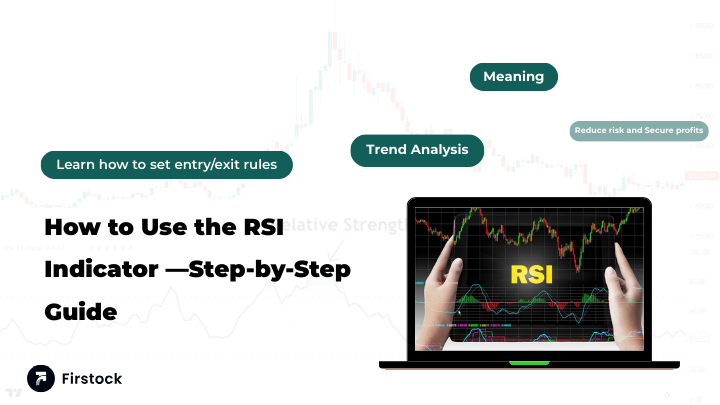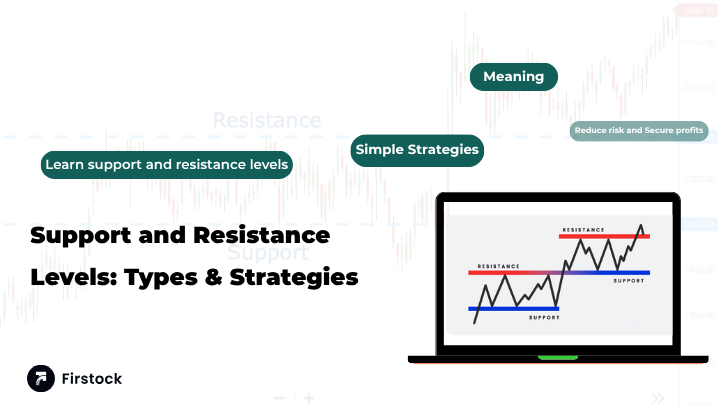How to Use RSI Indicator —Step-by-Step Guide| 2026

How to Use RSI Indicator on Firstock: Pro Guide for Smart Traders
Understanding technical indicators can be overwhelming, but the Firstock Option Trading App simplifies the process beautifully. In this revamped guide, we’ll cover exactly what is RSI indicator, how to use RSI indicator smartly, identify RSI indicator buy and sell signals, and leverage Firstock’s unique strengths for effective trading. Whether you're starting or already trading, this article focuses on clarity, value, and a professional approach—not gimmicks.
Introduction to RSI: Basic Concept
The Relative Strength Index (RSI) is a popular and powerful momentum oscillator that traders worldwide rely on. It helps you understand the strength and speed of price movements for any stock or asset.
Think of the case where you are running behind a runner, you may notice that the runner is over pushing herself or himself and may anticipate that the runner may slow down soon. RSI operates on the same principle - it is an indicator that price momentum may have reached an excessive point and a reversal might occur.
RSI assists traders to predict possible reversals or trend extensions prior to their occurrence providing an advantage in timing entries or exits.
How RSI Is Calculated & Default Settings
RSI calculations are technical but done automatically by charting tools, so you don’t need to compute anything yourself. Here’s how it works in short:
- RSI = 100 – (100 / (1 + RS)) where RS (Relative Strength) is average gain / average loss over a defined period.
- The default period used by most traders is 14 time periods (e.g. days on a daily chart).
That 14-period setting helps balance responsiveness and reliability in RSI signals. If you choose shorter periods, signals become quicker but potentially less stable; longer periods smooth out signals more.
What RSI Values Mean: Overbought, Oversold, Neutral
One of the key strengths of RSI is its easy-to-read scale from 0 to 100.
- Above 70: Generally considered overbought. This means price momentum may have peaked.
- Below 30: Generally considered oversold — price may be undervalued in the short term.
- Between 30 & 70: Neutral zone — price momentum is stable; no extreme reading.
Understanding where RSI stands helps you interpret market strength and potential reversals with clarity—critical for timing trades.
Identifying RSI Indicator Buy and Sell Signals
RSI gives actionable signals when interpreted properly. Below’s how to spot them:
Buy Signals
- RSI dips below the oversold threshold (e.g. 30), then climbs back above it.
- This signals rising momentum after potential weakness, offering a buy opportunity.
Sell Signals
- RSI goes above the overbought level (e.g. 70), then falls back below it.
- Indicates potential exhaustion in upward momentum—could be a selling or exit signal.
You can also use mid-point (50) to gauge momentum direction: often, readings above 50 may indicate bullish bias and below 50 may indicate bearish bias. Some traders use it for extra confirmation.
Understanding RSI Divergence & Failure Swings
For advanced signal identification, two powerful concepts are divergence and failure swings:
Divergence
- Bullish divergence: Price makes a lower low, but RSI makes a higher low → signalling weakening downward momentum and potential reversal.
- Bearish divergence: Price makes a higher high, but RSI forms a lower high → warning of weakening upward momentum.
Failure Swings (Swing-Failure Pattern)
- RSI moves into overbought or oversold territory, pulls back, attempts again, fails to surpass previous extreme, then moves opposite efficiently. This setup can be a strong reversal signal without relying on price alone.
These methods make your strategy robust by adding contextual confirmation—not just relying on raw levels.
Using RSI in Trend vs Range Markets
While the standard overbought/oversold rule works well, interpretation should adapt to market conditions:
- In trending markets, stocks may stay overbought or oversold for extended times. Using RSI alone in such markets may generate false signals.
- Traders often adjust thresholds during strong trends—some use tighter or relaxed zones to avoid early exits.
- In range-bound markets, RSI works remarkably well: overbought → sell/exit, oversold → buy/enter.
Hence, always combine RSI reading with an understanding of the overall market condition before acting.
Overview of Firstock: Key Features & What Makes It Unique
Firstock is not like every other stock trading app—it’s built to empower traders and investors with tools, transparency, and convenience. Here are some of its standout strengths:
- Zero brokerage on equity delivery trades.
- Transparent pricing, with no hidden charges—perfect for cost-conscious traders.
- Supports a wide range of trading & investment products: stocks, direct mutual funds, futures & options (F&O), ETFs, sovereign gold bonds, government securities, IPOs, and more.
- Seamless instant account opening process and secure login.
- Charting and technical tools are advanced and user-friendly—including integration with trading-view and options for heatmap, real-time alerts, order book views, etc.
- The platform is SEBI-registered, ensuring regulatory safety and reliability for Indian users.
All of these features help traders—new and experienced—execute an RSI-focused strategy in a fast, cost-effective, and safe environment.
How to Use RSI Indicator Inside the Firstock App – Step by Step
Here’s a practical walkthrough on using RSI via Firstock:
- Open the Firstock app and log in.
- Navigate to the chart view for any stock, index, or asset you're interested in.
- Locate the Indicators menu or section—Firstock offers advanced chart tools suitable for technical analysis.
- Search/select “Relative Strength Index (RSI)” from the list of available indicators.
- Set the period (default 14 recommended for balanced signals).
- Apply to chart. You will see a sub-chart/oscillator window beneath price data plotting the RSI line from 0 to 100.
- Monitor RSI behavior — check for signals (overbought, oversold, divergence) and confirm with price/other context before making decisions.
Using Firstock’s smooth interface and responsive charts makes this process quick and efficient—ideal for traders who want speed without complexity.
Suggested RSI Trading Strategies for Beginners & Pros
Here are tested, simple strategies structured for clarity and success:
Strategy A: Basic Oversold/Overbought Swing
- Wait for RSI to go below 30 → signal of oversold condition
- Confirm price support or chart pattern
- Enter long (buy), set stop-loss below recent swing low
- Exit/Take profit when RSI goes above 70 or according to risk strategy
Strategy B: Divergence Reversal Entry
- Spot bullish/bearish divergence between price and RSI (see section 5)
- Use a lower time-frame confirmation in Firstock chart before executing
- Manage risk strictly if price moves against signal
Strategy C: Trend-Based Pullback Setup
- Identify the overall price trend (up or down)
- In an uptrend: look for RSI pullbacks (e.g. from above 70 down toward 50 or 40) to enter long trades
- In a downtrend: look for RSI rallies (e.g. from oversold zones) to enter shorts or exit longs
Keep in mind: no strategy is foolproof. Even the best RSI setups need risk management and confirmation.
Combining RSI with Other Tools for Confirmation
RSI performs best when combined with complementary indicators/analysis techniques:
- Moving Averages (MA): Helps identify trend direction; if RSI says oversold but price is below a key MA, wait for alignment.
- Support & Resistance Levels / Price Action: Chart patterns + RSI strengthen setup reliability.
- Volume Analysis: Rising volume during breakout/crossover signals validates moves around RSI levels.
- Other Indicators (e.g. MACD, Bollinger Bands): Use them as filters—not to confuse, but to confirm.
- Trendlines on RSI Chart: Drawing trendlines directly on RSI can show momentum breakout/weakness independent of price.
This multi-layered confirmation reduces risk, increases clarity, and prevents false signals.
Risk Management & Avoiding Common Pitfalls
While RSI is a popular tool, it’s not infallible. Here are common mistakes and risk solutions:
Good risk management will protect capital and improve longevity in trading, especially when experimenting with momentum indicators like RSI.
Optimizing RSI Settings Based on Time-Frame & Asset Type
Although the 14-period setting works generally, you can fine-tune it according to your trading style or the asset:
- Short-term / intraday traders: Try shorter periods (e.g. 9 or 7) for quicker signals—but expect more noise.
- Swing or long-term traders: Stick with default 14 or even longer to avoid over-reacting to minor moves.
- Volatile assets (Futures & Options, high-beta stocks): Monitor RSI readings more conservatively; use combined strategies for safety.
- Less volatile assets or indices: Standard settings often deliver reliable setups; just adjust risk tolerance accordingly.
Any change in settings must be back-tested (using past charts or paper trading) to ensure it works for that asset type and strategy.
How Firstock Enhances Your RSI-Based Trading Experience
Firstock’s platform specifically complements RSI trading through:
- Advanced Charting Tools: High-quality chart windows and responsive indicators let you clearly view RSI zones, trendlines, and divergence without lag.
- Real-Time Data & Alerts: Instant updates and price-alert push notifications help you act on RSI signals without delay.
- Flexible Product Access: Whether you trade equity, derivatives (F&O), or invest via mutual funds, Firstock covers it all—so RSI strategies stay consistent across products.
- Cost Advantage: Zero brokerage on delivery trades helps you keep more profits when your RSI-based strategy works out.
- User Support & UI Feedback: The app’s clean interface and user reviews highlight ease of navigation and good customer support, helping traders stay confident.
These advantages make Firstock more than just another trading app—it’s a professional partner for informed traders and investors.
Realistic Expectations: What RSI Can and Cannot Do
It’s important to keep your expectations realistic about what RSI can deliver:
What RSI can do:
- Offer signals on momentum strength and possible reversals
- Help you time entries/exits better when used properly
- Assist in building structured strategies with logic
What RSI cannot guarantee:
- Never works perfectly in all market conditions—false signals can and do occur, especially during strong trends or high volatility.
- Should not be used in isolation without price context or risk controls
- Cannot predict external factors (news events, macro shifts) that can override technical indicator signals
By combining RSI signals with good strategy, context, and discipline—especially via tools in Firstock—you can trade smarter and more sustainably.
Conclusion & Action Plan
When you are serious about trading or investing, then you can have an advantage of mastering RSI. You can substitute this with a platform such as Firstock, which is known to have zero brokerage,discount broker, transparent pricing, real-time data and advanced charting all the ingredients to professional trading.
Your action plan:
- Start with the basic 14-period RSI in Firstock charts.
- Practice simple oversold/overbought trades with small size or in a paper-trading mindset.
- Gradually incorporate divergence and trend-based strategies.
- Combine RSI signals with price action, volume, and support/resistance.
- Always use risk management—stop-losses, position sizing, and strategy evaluation.
Stay disciplined, keep learning, and let RSI + Firstock work together for your trading success.
FAQs
1. Can I rely on RSI alone for making trading decisions?
No. RSI is a powerful indicator but works best when combined with chart analysis, volume, and trend confirmation to reduce the risk of false signals.
2. What is rsi indicator setting for long-term investing?
A 14-period setting is widely recommended for consistency and reliability; you can adjust cautiously based on asset and timeframe.
3. Is Firstock safe for derivative trading with RSI strategies?
Yes. Firstock offers futures & options trading and is SEBI-registered for these segments, making it suitable for derivative traders.
4. How should I react if RSI stays overbought/oversold for a long time?
Trend strength can keep RSI in extreme zones longer than expected. In such cases, wait for divergence, failure swings or price confirmation before trading against the trend.
5. Can I use RSI signals for other products on Firstock like mutual funds or gold bonds?
Yes, but adapt your strategy depending on product volatility. RSI works best on assets with regular price fluctuations—you may want to combine it with longer-term fundamentals for stable products.





